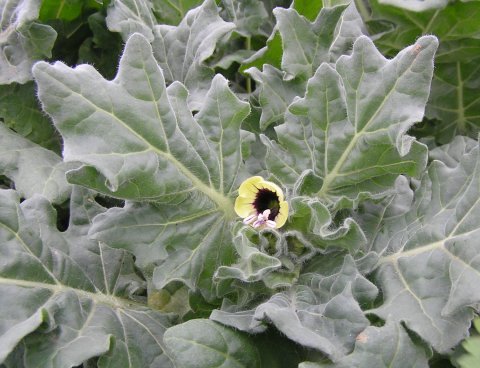 Image by Manuel Luis Gil González from Wikimedia Commons , originally from Flora Vascular de Canarias |
 Image by Javier martin from Wikimedia Commons |

Synonymy
*Hyoscyamus albus L., Sp. Pl. 1: 180 (1753)
T: Habitat in southern Europe; Herb. LINN. 244.2, n.v., fide E. Schönbeck-Temesy, Fl. Iranica 100: 69 (1972).
See the Linnaean Plant Name Typification Project pages.
Description
Annual, biennial or perennial herb to 50 cm.
Leaves orbicular-ovate, the lamina 4–10 cm long, deeply toothed; petiole 1–5 cm long.
Lowest flowers with pedicels to 8 mm long, other flowers sessile. Calyx 10–15 mm long, the lobes broadly triangular, 1.5–2.5 mm long. Corolla to 30 mm long, usually cream or white, the throat tinged with green or purple. Anthers included or slightly exserted.
Fruiting calyx broadly tubular-campanulate, slightly swollen in lower half, 20–25 mm long.
Distribution and ecology
Known mostly from early collections from scattered localities in south-eastern Qld, Vic. and Tas.
Common name
White Henbane
Selected specimens
Qld: Brisbane, 13 Oct. 1976, D. Martin (BRI). Tas.: Hobart, Dec. 1876, W.W. Spicer (HO).
Derivation of epithet
From the Latin albus, meaning white.
Images and information on web
An image of a flowering plant of Hyoscyamus albus can be found at http://botany.cs.tamu.edu/FLORA/perdeck/spa_041.jpg
There are some high resolution images of this species at http://www.plantsystematics.org/
An illustration of this plant as plate 111 in the 1737 A curious herbal can be seen in the Rare Books from the MBG Library of Missouri Botanical Garden at http://www.botanicus.org/name/Hyoscyamus_albus
A considerable number of images appear with a Google Images search. Some of these will represent incorrectly named plants, but the majority are correct. See for instance
http://crdp2.ac-besancon.fr/flore/flore/Solanaceae/especes/hyoscyamus_albus.htm
where flowers are shown with and without the darker centre and www.floracyberia.net/spermatophyta/angiospermae/dicotyledoneae/solanaceae/hyoscyamus_albus.html where there is a close-up of the flower and leaves and hairs are visible.
Information about the toxic properties of this plant can be found with a search in the FDA Poisonous Plant Database